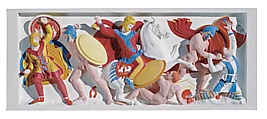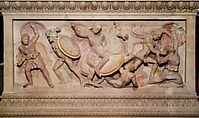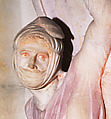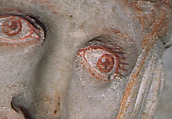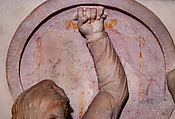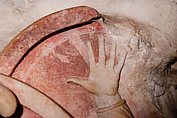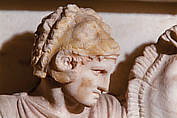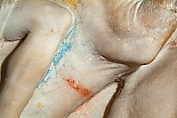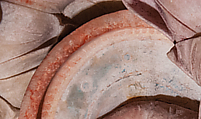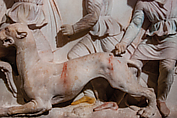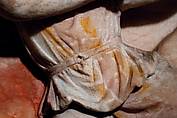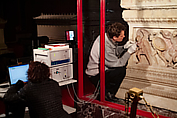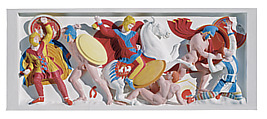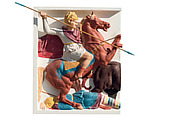Returned to lender The Met accepts temporary loans of art both for short-term exhibitions and for long-term display in its galleries.
Reconstruction of one side of the so-called Alexander Sarcophagus, with a battle between Greeks and Persians Variant A
Vinzenz Brinkmann German
Ulrike Koch-Brinkmann
Not on view
The sarcophagus was likely commissioned to preserve the mortal remains of the Sidonian king Abdalonymus, a friend of Alexander the Great. The well-preserved polychromy on the original marble features painterly techniques such as highlights and chiaroscuro. Twenty-two different pigments have been identified through ultraviolet-visible absorption spectroscopy. The figures’ garments, horse blankets, and shields are richly ornamented, and physical features are well-delineated. A scene depicting a royal audience with the Persian king is painted on the interior of a Persian warrior’s shield, displayed to both his Greek enemy and the viewer of the relief. The painting is clearly visible on the original in ultraviolet-induced visible luminescence imaging.
"The marble sarcophagus from the royal cemetery of Sidon (in present day Lebanon) contained the mortal remains of King Abdalonymus, a friend of Alexander the Great. The sarcophagus was built to resemble a small temple, with a saddle roof and elaborate ornamentation including pedimental sculptures and a continuous frieze Alexander himself is depicted twice among the many figures on the relief friezes: once on horseback in a battle with the Persians and a second time with Sidonian friends in an animal hunt.
The original polychromy of the sarcophagus is well-preserved. No fewer than 22 pigments have so far been identified with the help of ultraviolet-visible absorption spectroscopy (UV-Vis spectroscopy). Both Eastern and Greek garments are richly ornamented, and the saddle cloths and shields are decorated with both ornamental motifs and figures. On the short side the Greek Macedonian warriors are represented as idealized nudes, but armored. The splendid Persians’ garments have been worked out in great detail, for example the fur lining on their colorful cloaks and the delicate ornaments on their pants. The interior of a Persian warrior's shield displays to both his Greek enemy and to the viewer of the relief a scene of a royal audience at the Persian court.
The application of color creates the effect of light and shadow painting. So, for example, there are highlights in the eyes and the shiny metal buttons, while on the garments, the use of hatching creates the effect of shadows and drop shadows. The hair is modeled with light and dark effects.
The reconstruction of the battle of Greeks and Persians on one of the short sides was carried out on the basis of the preserved traces of color. Very few remnants of the light reddish skin color are preserved. As a test case, three versions of the head of the Persian with the audience scene on his shield show three different interpretations of the preserved traces of paint, with variations in the color of both the hair and the flesh. The preserved traces could be understood as merely the first layer of color, which was followed by more layers, in order to model the figures to achieve the effect of light and shadow painting.
The figure of Alexander in the battle of Greeks and Persians on one of the long sides was completely covered with paint in the reconstruction, with the missing colors restored on the analogy of comparable works."
Vinzenz Brinkmann and Ulrike Koch-Brinkmann
Reconstruction, Variant A 2006:
Vinzenz Brinkmann und Ulrike Koch-Brinkmann
marble stucco on laser-sintered artificial material, natural pigments (chromatographically calibrated) in egg tempera
H. 56.5 cm, W. 137.5 cm.
3D-printing: Ursula Buck, Thorsten Schwing, GOM Braunschweig, Alphaform Munich; restorations: Joseph Köttel
Liebieghaus Skulpturensammlung (Liebieghaus Polychromy Research Project), Frankfurt am Main, inv.St.P 701
Scientific methods employed:
Ultraviolet-induced visible luminescence imaging (UVL) (Schott KV 418)
Ultraviolet-reflected imaging (UVR) (Schott UG1 or Schott BG12)
Optical stereoscopic microscopy (10–50x, Zeiss and Olympus)
Raking light imaging (Schott KL1500)
Visible-reflected imaging in black and white (VIS)
Color imaging in visible light (VIS)
Photomicrograph (with microscope or macro objectives)
3D-scan in structured light (GOM Atos)
Ultraviolet-visible absorption spectroscopy (UV-Vis spectroscopy)
Scientific evaluation:
Vinzenz Brinkmann, Ulrike Koch-Brinkmann, Heinrich Piening
Pigments used in the reconstruction:
blue: Egyptian blue; red: red ocher, madder lake, minium; violet: rose madder, hematite; yellow: iron oxide, gold ocher, terra di Siena; brown: brown ocher, goethite, umbra; white: lead white, calcite; black: charred bone; flesh tones: calcite
Acknowledgements:
Archaeological Museum, Istanbul
GOM Braunschweig
Ursula Buck, Thorsten Schwing
Due to rights restrictions, this image cannot be enlarged, viewed at full screen, or downloaded.
This artwork is meant to be viewed from right to left. Scroll left to view more.
